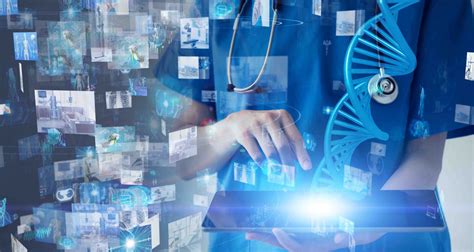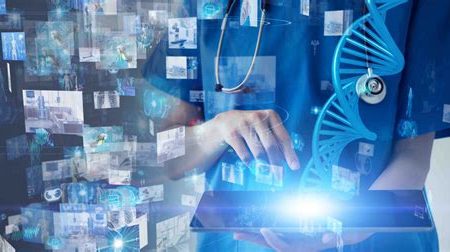The future of healthcare is evolving at a rapid pace, and much of this progress is driven by technology. From telemedicine to wearable devices and artificial intelligence, the healthcare industry is being transformed in ways that were once unimaginable. In this blog post, we will explore the cutting-edge innovations that are shaping the future of medicine and revolutionizing patient care. From the use of artificial intelligence to enhance diagnosis and treatment, to the potential of blockchain to secure patient data, and the power of wearable devices to empower individuals to monitor their own health, we will delve into the ways in which technology is reshaping the healthcare landscape. Join us as we explore the exciting world of Healthcare 2.0 and the many ways in which technology is revolutionizing the way we approach healthcare.
Table of Contents
Telemedicine: Revolutionizing Healthcare Access
Telemedicine, the use of telecommunication and information technology to provide clinical healthcare from a distance, is revolutionizing the way patients access medical care. With telemedicine, individuals are no longer limited by geographical barriers when it comes to seeking medical advice and treatment. This means that people in remote or rural areas can now connect with healthcare providers and specialists without having to travel long distances.
Furthermore, telemedicine is enhancing access to healthcare for individuals with mobility issues or those who are unable to leave their homes, such as the elderly or individuals with disabilities. With the use of telemedicine platforms, patients can conveniently consult with doctors, receive prescriptions, and even have virtual check-ups from the comfort of their own homes.
In addition, telemedicine is also playing a crucial role in emergency situations, allowing medical professionals to provide immediate assistance and guidance to patients in need, regardless of their location. This has proven to be life-saving in many cases, especially in situations where time is of the essence.
Overall, the implementation of telemedicine is transforming the traditional healthcare model by making it more accessible, convenient, and efficient for patients, ultimately improving the overall quality of healthcare.
Artificial Intelligence in Medicine: Enhancing Diagnosis and Treatment
Artificial intelligence (AI) has become a game-changer in the field of medicine, revolutionizing the way healthcare providers diagnose and treat patients. Using advanced algorithms and machine learning, AI has the potential to enhance the accuracy and efficiency of medical diagnosis.
One of the most exciting applications of AI in medicine is in the field of medical imaging. AI algorithms have been developed to analyze medical images, such as X-rays, MRIs, and CT scans, to detect abnormalities and assist radiologists in making more accurate diagnoses. This technology has the potential to significantly reduce the time it takes to diagnose conditions, leading to earlier treatment and better patient outcomes.
Additionally, AI is being used to develop personalized treatment plans for patients. By analyzing large volumes of patient data, AI algorithms can identify patterns and trends that can help healthcare providers tailor treatment plans to individual patients. This not only improves the quality of care but also reduces the risk of adverse reactions to medications and treatments.
Furthermore, AI has the potential to revolutionize the drug discovery process. By analyzing massive datasets, AI algorithms can identify potential drug candidates and predict how they will interact with the human body. This could significantly accelerate the development of new drugs and lead to more effective treatments for a wide range of medical conditions.
Wearable Devices: Empowering Individuals to Monitor Their Health
Wearable devices have revolutionized the way individuals track and monitor their health. These devices, which include smartwatches, fitness bands, and other wearable technology, allow users to keep a constant eye on their physical activity, heart rate, sleep patterns, and more. By providing real-time data and personalized insights, wearable devices empower individuals to take control of their health and make informed decisions about their well-being.
Moreover, wearable devices are not only limited to tracking physical activity but also monitor various health metrics such as blood pressure, glucose levels, and ECG readings. This continuous monitoring can provide early warning signs of potential health issues, allowing individuals to seek timely medical intervention. The ability to access such vital health information at any time can be life-saving and transformative for those with chronic conditions or individuals at risk of developing certain health problems.
Furthermore, the data collected from wearable devices can be shared with healthcare providers, enabling a more comprehensive and accurate assessment of an individual’s health. This collaboration between users and healthcare professionals can lead to more personalized and effective treatment plans. Additionally, the aggregated data from these wearable devices can contribute to population health research, ultimately leading to advancements in healthcare and disease prevention.
In conclusion, wearable devices play a crucial role in empowering individuals to actively participate in their own health management. By leveraging the capabilities of wearable technology, individuals can gain valuable insights into their health, improve their overall well-being, and contribute to the advancement of healthcare as a whole.
Blockchain in Healthcare: Securing Patient Data and Streamlining Processes
In the current healthcare landscape, securing patient data and streamlining processes are top priorities for healthcare providers and organizations. The use of blockchain technology has emerged as a promising solution to address these challenges. Blockchain, which is essentially a decentralized and distributed digital ledger, offers a high level of security and transparency, making it ideal for healthcare data management.
By leveraging blockchain technology, healthcare organizations can ensure the integrity and privacy of patient data. The use of cryptographic algorithms and consensus protocols in blockchain provides a tamper-proof and immutable record of patient information, minimizing the risk of data breaches and unauthorized access. This enhanced security not only benefits patients but also enables healthcare providers to comply with stringent data privacy regulations such as the Health Insurance Portability and Accountability Act (HIPAA).
Furthermore, blockchain technology has the potential to streamline healthcare processes by enabling secure and efficient data exchange among stakeholders. Through smart contracts and digital signatures, healthcare providers can automate and optimize various administrative and clinical processes, including claims processing, supply chain management, and care coordination. This not only improves operational efficiency but also reduces the administrative burden on healthcare organizations, allowing them to focus on delivering high-quality patient care.
Overall, the integration of blockchain technology in healthcare holds immense promise in securing patient data and streamlining processes. As the industry continues to embrace digital transformation, blockchain is poised to revolutionize the way healthcare data is managed and shared, ultimately leading to improved patient outcomes and experiences.
Virtual Reality: Transforming Patient Care and Medical Training
Virtual reality (VR) technology has significantly transformed the landscape of patient care and medical training in recent years. The immersive experience provided by VR has revolutionized the way medical professionals diagnose and treat patients, as well as how aspiring healthcare professionals receive training.
VR allows patients to be transported to alternate environments, reducing anxiety during medical procedures. This has proved especially beneficial in pain management and rehabilitation, with patients reporting lower levels of discomfort and faster recovery times. The ability to distract and immerse patients in a virtual world has also been effective in reducing pre-surgical stress and anxiety.
In terms of medical training, VR simulations offer a realistic and safe environment for healthcare students and professionals to practice complex procedures and surgeries. This innovative technology enables them to gain hands-on experience without posing any risk to real patients. As a result, medical professionals can refine their skills and judgment, ultimately improving patient outcomes.
The integration of VR in patient care and medical training has not only enhanced the overall experience for both patients and healthcare professionals, but it has also paved the way for future advancements in the field of medicine. As technology continues to evolve, VR is poised to play an increasingly crucial role in reshaping the healthcare industry.
Internet of Things (IoT) in Healthcare: Connecting Patients and Providers
In today’s fast-paced world, technology has become an integral part of healthcare. One of the most significant advancements in this field is the Internet of Things (IoT). IoT refers to the interconnected network of devices that can communicate and exchange data with each other. In healthcare, IoT is revolutionizing the way patients and providers interact, as well as how medical devices and systems are managed.
Through the use of IoT devices, patients are able to monitor their health in real-time and share their data with healthcare providers. This constant stream of information allows for more personalized and proactive care, as healthcare professionals can intervene at the earliest signs of trouble. Additionally, IoT devices can be used to administer medication reminders, track physical activity, and even monitor chronic conditions, all from the comfort of a patient’s home.
On the provider side, IoT enables healthcare professionals to remotely monitor their patients, analyze trends in health data, and make informed decisions about treatment plans. This not only improves the quality of care but also reduces the need for frequent in-person visits, ultimately cutting down on healthcare costs for both patients and providers.
Furthermore, the use of IoT in healthcare extends beyond patient monitoring. It also includes the management of medical inventory, tracking the location and status of equipment, and optimizing the use of resources within a healthcare facility. This level of connectivity and automation not only streamlines processes but also ensures that healthcare facilities are operating at their most efficient capacity.
Precision Medicine: Personalized Healthcare for Better Patient Outcomes
Precision medicine, also known as personalized medicine, is a revolutionary approach to healthcare that takes into account each individual’s unique genetic makeup, environment, and lifestyle. This approach allows healthcare providers to tailor medical treatment and preventive measures to the specific characteristics of each patient, leading to better outcomes and improved quality of care.
By utilizing advanced diagnostic tools and technologies, healthcare professionals can identify genetic, molecular, and cellular markers that may predispose individuals to certain diseases or influence their response to medications. This information allows for the development of targeted therapies and interventions that are tailored to the individual patient, maximizing the effectiveness of treatment while minimizing the risk of adverse reactions.
One of the key benefits of precision medicine is its potential to transform the management of chronic diseases, such as cancer, cardiovascular conditions, and diabetes. By understanding the unique genetic and molecular drivers of these diseases in each patient, healthcare providers can create personalized treatment plans that are more effective in controlling the progression of the disease and improving the patient’s overall health and well-being.
Furthermore, precision medicine has the potential to revolutionize preventive care by enabling healthcare providers to identify individuals who may be at increased risk of developing certain health conditions based on their genetic predisposition. This allows for early intervention and targeted preventive measures, ultimately leading to better health outcomes and reduced healthcare costs.
Robotic Surgery: Advancements in Minimally Invasive Procedures
Robotic surgery has revolutionized the field of medicine, particularly in the area of minimally invasive procedures where precision and accuracy are crucial. With the advent of robotic technology, surgeons are now able to perform complex surgeries with greater dexterity and control, leading to improved patient outcomes and faster recovery times.
One of the key advancements in robotic surgery is the use of smaller, more flexible robotic arms that can access hard-to-reach areas of the body, allowing for more precise incisions and reduced trauma to surrounding tissues. This has paved the way for minimally invasive procedures, which offer patients less pain, scarring, and a shorter hospital stay.
Furthermore, the integration of artificial intelligence into robotic systems has allowed for real-time feedback and adjustments during surgery, further enhancing the precision and safety of the procedure. This marriage of technology and medicine has truly transformed the landscape of surgical care, offering patients a less invasive and more effective treatment option.
As robotic surgery continues to evolve, it holds the promise of expanding the range of procedures that can be performed with minimally invasive techniques, ultimately benefiting patients by providing them with safer, more efficient, and less traumatic surgical options.
Big Data Analytics in Healthcare: Harnessing Information for Improved Decision Making
Big data analytics has transformed the healthcare industry by enabling healthcare providers to harness vast amounts of information for improved decision making. With the help of advanced technology and powerful analytics tools, healthcare organizations can now analyze large datasets to identify trends, patterns, and insights that can be used to improve patient care, optimize operations, and reduce costs.
The use of big data analytics in healthcare has revolutionized the way medical professionals diagnose and treat patients. By analyzing patient data such as medical histories, lab results, and imaging studies, healthcare providers can gain a deeper understanding of each patient’s unique healthcare needs. This personalized approach to medicine has led to improved patient outcomes and a higher quality of care.
In addition to improving patient care, big data analytics has also helped healthcare organizations make more informed decisions about resource allocation, risk management, and strategic planning. By analyzing data related to patient outcomes, treatment effectiveness, and operational efficiency, organizations can identify areas for improvement and implement targeted interventions to drive positive change.
Overall, the use of big data analytics in healthcare has the potential to revolutionize the industry by unlocking valuable insights, improving decision making, and ultimately, enhancing patient care and outcomes.
Genomics and Gene Editing: Unlocking the Secrets of Disease
Genomics and gene editing are rapidly changing the landscape of healthcare, offering new possibilities for understanding and treating diseases. With the advancements in technology, scientists can now examine the entire genetic makeup of individuals, providing insights into the underlying causes of various health conditions.
By unlocking the secrets of disease at the molecular level, researchers are able to develop more targeted and personalized treatment approaches. Gene editing techniques such as CRISPR have shown promise in correcting genetic abnormalities that contribute to certain diseases, offering hope for patients with previously untreatable conditions.
Furthermore, genomics and gene editing have the potential to revolutionize preventative medicine, allowing for early detection of genetic predispositions to diseases and enabling interventions before symptoms even appear. This transformative shift towards precision medicine has the power to improve patient outcomes and reduce the burden of illness on individuals and healthcare systems.
As we continue to unlock the genetic secrets of disease, it is essential to consider ethical and regulatory implications to ensure that these technologies are used responsibly and equitably, minimizing potential risks and maximizing benefits for all.






